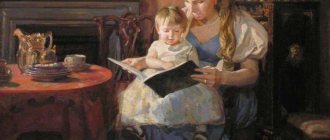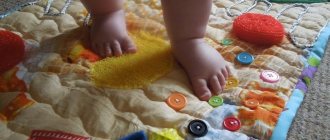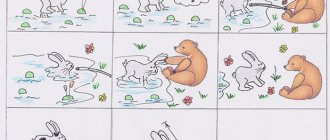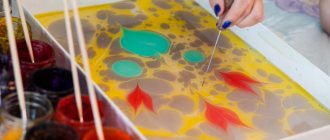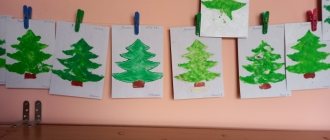Fairytale therapy in a preschool educational institution - interview with a therapist
Fairy tales are needed not only to make it more fun for children to fall asleep. With their help, you can learn about your baby’s problems, correct his behavior, teach him to count and develop his imagination.
We talked about the possibility of fairy tale therapy with art therapist Galina Fedorova.
— Which fairy tales are better to tell a child – your own, folk or author’s?
— You should definitely read folk tales, they contain deep meanings!
Copyrights are usually dedicated to a specific problem. You can contact them, but choose those that you like and are close in spirit. If the theme of a fairy tale is relevant to your situation, take it as a basis, but be sure to add something of your own, individual.
Stories invented by the parents themselves make it possible to most fully portray the reality that is relevant to the child.
A sick example of fairy tale therapy
For example, such fairy tale therapy in a preschool educational institution - my doll - a toy crow - flew to the cancer hospital. She flies there and sees food untouched by anyone. Children there often don’t eat at all. The crow began to croak: “Oh, I’m full now, such a cool soup and pasta!” Oh, and this, and this, I’ll eat everything.”
And then one boy: “No, I’ll eat it.” “Are you sure you’ll eat it? Well, show me, show me!”
And the child begins to eat. Therefore, plots are ready, there can be blanks, but it’s better when they are born in the head every minute.
You don’t immediately run to look on the Internet for a fairy tale in which the child does not eat. It’s easier and faster to come up with ideas on the spot and beat the situation.
“I know that many modern parents are embarrassed by the cruelty of folk tales.
- There is such a problem. We even had a discussion at the festival about whether bloody scenes should be removed from modern stories. For example, when a warrior kills or when Herod's head is cut off.
Once upon a time I myself removed all these scenes from my performances. I thought why would I show children how they cut off the head, even of a villain. People used to be more prepared for such tough scenes, they perceived them normally, and living conditions were more difficult.
Now I am no longer so categorical about this. I speak out to turn it all into a tragic farce, to use humor. But, of course, nothing should be taken to the point of absurdity.
— What if a child comes up with a fairy tale on his own, or do you need to help him?
- If there is an opportunity not to interfere, then it is better not to interfere. If a child has difficulties in composing a fairy tale, or some kind of stupor, then you need to help, but very gently, in the form of a question: “Or maybe it’s like this?”
Fairytale therapy in preschool educational institutions - Methodology “Association for Droodles”
The development and use of doodles with preschoolers helps develop associative thinking, divergence and creativity in them, forms their memory, children learn to come to non-standard approaches to various problems. The opinion formed by the child is necessarily justified by himself. And thus the baby’s speech activity develops.
Doodles with younger preschoolers
You can start using doodles in working with children from the youngest group (4th year of life).
At the initial stages of working with droodles, it is worth using subject images in which you can see a fragment of the proposed droodle. For example: the teacher shows a doodle in the form of a bracket and says: “Look at this picture. What were you thinking? It is imperative to draw children's attention to the details of the object, emphasizing their similarity to a droodle.
So, the semicircle looks like a bear’s ear, like the back of a mouse. Squares are like windows in a house, a scarf or a blanket.
Doodles in middle groups
When working with children in the middle group (5th year of life), auxiliary subject images are no longer needed; children are shown a doodle and asked the question: “What did you think about when you saw this picture?”
Children love instant transformations when the teacher creates appropriate images based on their ideas. So from drops of water you can draw a cloud - and it’s already raining, based on the wavy lines we draw a mouse, add a roof to the square - and you get a house, circles with tails and leaves turn into apples and the like. In one image you can see dozens of different situations.
Doodles for older preschoolers
Continuing to work with children of the older group (6th year of life), you can use both all previous groups, as well as new, more complicated ones. Lessons should be organized on topics within which children will need to create associative images. You can invite children to come up with their own droodles and justify them.
In this type of work there are no false and only correct answers - every well-founded opinion has the right to exist. The main thing is that the activity for children is interesting, entertaining, and educational.
The purpose of classes using the fairy tale therapy method is
harmonization of the emotional and personal development of each child, the formation of his strong-willed qualities and creative abilities.
Main goals:
- Development of fantasy and imagination.
- Developing the ability to express your thoughts.
- Developing the ability to listen to another, follow the course of his thoughts and the ability to fit your own thoughts and fantasies into the context of the story.
- Development of the ability to decenter, the ability to take the place of another, to look at the world from different angles
- Developing empathy.
- Expanding the repertoire of emotions and emotional states. Developing the ability to recognize them.
- Expanding knowledge about the phenomena of the surrounding physical and social world.
When working with preschool children, the technique most often used is Grabenko T., Zinkevich-Evstigneeva T., Frolov D. “The Magic Country is Within Us!”, as well as the author’s program “Intersection Point”.
Children love such activities very much. They unite the group, allow children to learn ways to relieve stress, new effective behavior patterns, etc.
